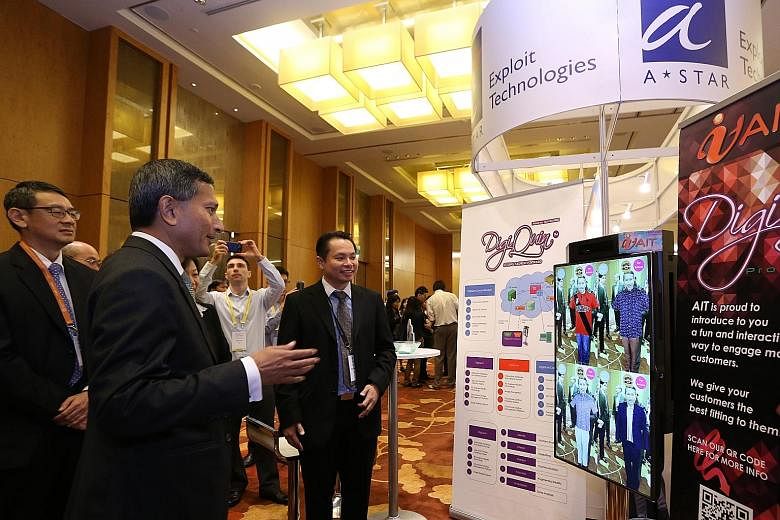Large local companies will be encouraged to invest in high-tech start-ups. They will get financial backing from a $40 million fund put aside by the National Research Foundation (NRF) to do this.
Together, the NRF and the big companies will co-invest in start-ups on a $1 for $1 basis that is relevant to the company's business.
This will build up specific technology ecosystems in areas such as advanced manufacturing or electronics crucial to Singapore in the shift to an innovation-driven economy.
Minister for the Environment and Water Resources Vivian Balakrishnan said the co-investment is a win-win for the investing company and the start-up.
"We've to try to eat our own dog food in order to refresh and update, to remain competitive by supporting the innovative start-ups," he said at the opening of Singapore's leading start-up conference Techventure yesterday. The dog food reference suggests that companies may have to use their own products to test the start-ups' technologies and business models.
Investee firms, in turn, can use the organisational resources of their corporate partner to overcome barriers to commercialisation and get access to networks and expertise to go global, said Dr Balakrishnan, who is also Minister-in-charge of the Smart Nation Initiative .
The NRF will evaluate good quality proposals. The successful companies will be told by March next year.
No further details on the scheme, which is called early stage venture fund (ESVF III), are available.
The ESVF is to develop the local start-up ecosystem. In 2008, the ESVF 1 committed $50 million in five venture capital firms on a $1 for $1 basis to co-invest in early stage companies. Six years later, in ESVF II, the NRF invested $10 million in each of five additional venture funds on a matching basis.
NRF's chief executive, Professor Low Teck Seng, told The Straits Times the ESVF III is an experiment to see if large local companies are interested in working with high-tech start-ups.
"The $40 million looks small but we can expand it if there're more companies wanting to start their own corporate venture funds."
Mr Stephen Lee, StarHub's head of i3 (Innovation, Investment and Incubation), said that the telco welcomes any effort by the Government to boost the start-up ecosystem in Singapore. "We will work closely with NRF to see how best we can participate in its initiative."
The corporate venture initiative was one of three announcements unveiled by Dr Balakrishnan to bolster the start-up ecosystem. The other two were a start-up exchange programme with Britain and a photonics industry consortium.
The exchange programme, called SG-UK joint test-bedding initiative, will enable start-ups from both countries to pilot and demonstrate technologies for future cities which include areas like mobility, a secure nation and water.
The initiative will let Singapore and British start-ups find reciprocal partnerships in each other's countries with companies, organisations and universities. The collaboration is supported by public agencies such as Spring Singapore, NRF, JTC Corp as well as Innovate UK and the British High Commission.
LUX Photonics Consortium seeks to strengthen and leverage on industry-tertiary institution ties to develop new applications.
It will tap the knowledge and technical expertise at the National University of Singapore, Nanyang Technological University and Agency for Science and Technology Research (A*Star). They will work with seven companies, including Technolite and DSO Laboratories, to seek breakthrough applications.
Dr Balakrishnan said: "Having fostered a dynamic start-up ecosystem, we will strengthen the linkages and connections across innovative enterprises."
To get breakthroughs, ideas, connections and money are needed from different actors to push back boundaries and open new vistas.
Photonics can be used in fibre-optic medical devices for diagnosis of coronary artery diseases and light- powered electronic circuits.
Dr Balakrishnan said it is important for Singapore to be involved in high-tech start-ups as, in the next 50 years, it is not better tweaks and add-on value creation that will make Singapore successful.
The next phase of growth for Singapore, he said, is to strengthen the connections between investors, entrepreneurs, start-ups, researchers and the public sector.
"Innovation, smart money and effective networks for global connections are what is needed for Singapore's future," he said.
Techventure is organised by the NRF. About 1,000 foreign and local attendees have signed up for the two-day event at the Marina Bay Sands convention centre.
About 160 companies from 13 countries are showcasing the latest technologies in areas like engineering, medical technology and clean energy.

